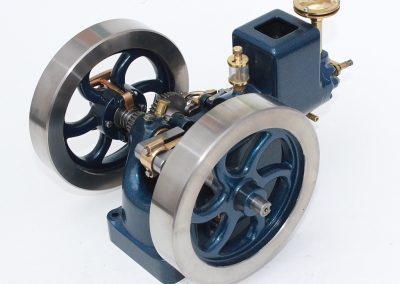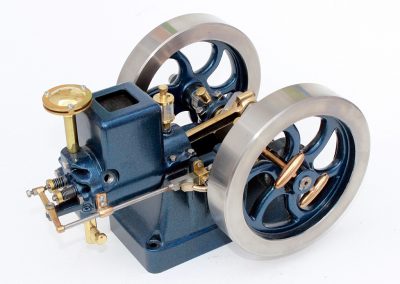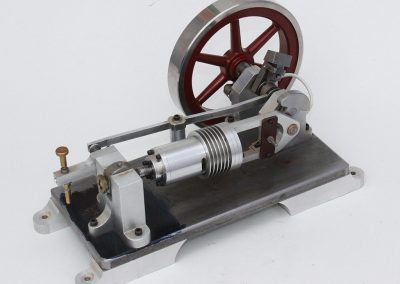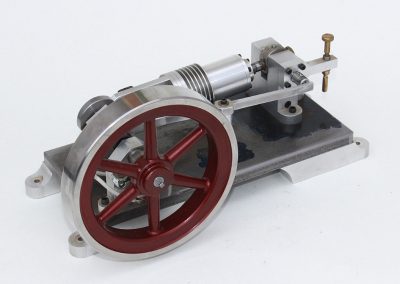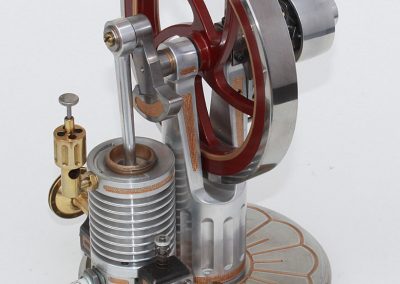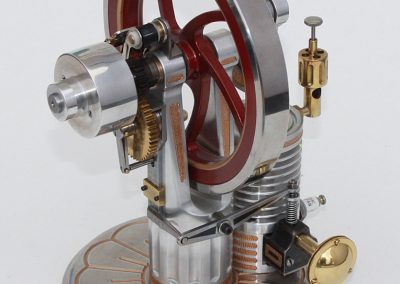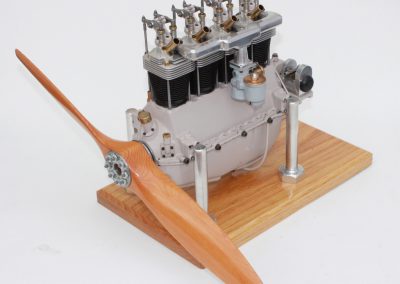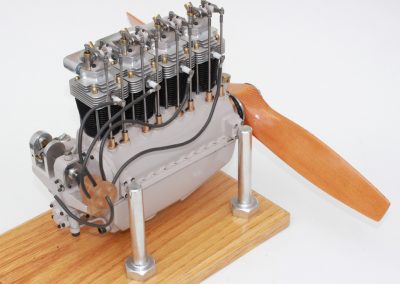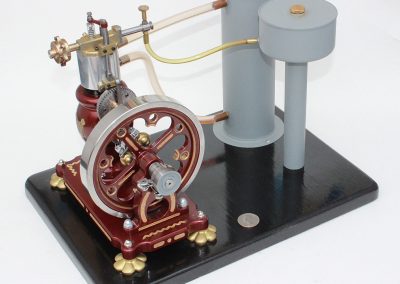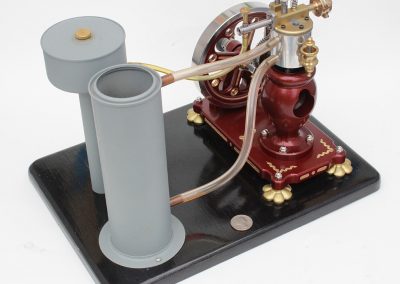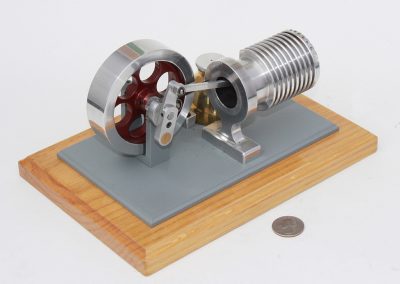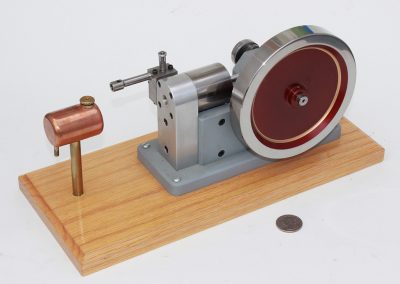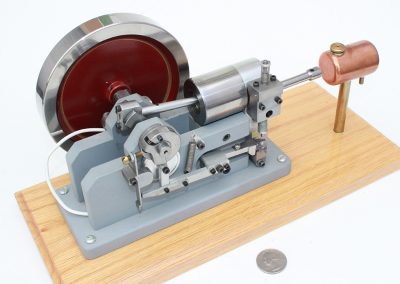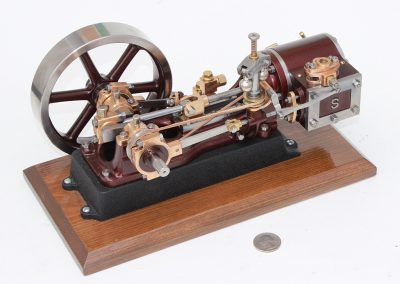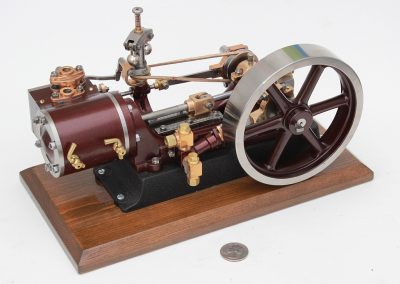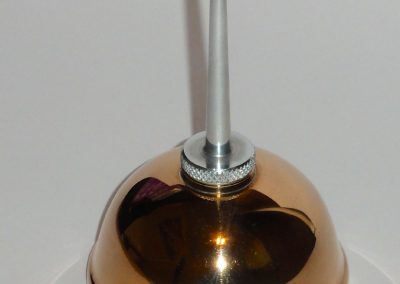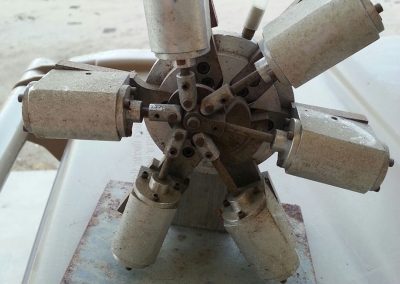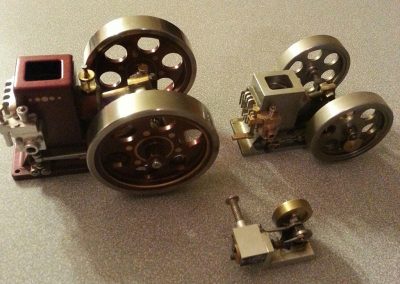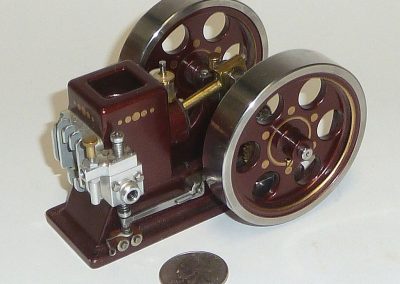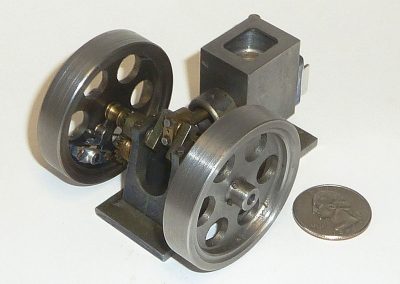Hit-n-Miss Engine
This twin flywheel hit-n-miss engine exhibits the solid design and excellent craftsmanship for which Phil Duclos was best known. It is similar in design to a documented engine Phil called the “Odds ‘n Ends” engine. It utilizes the curved spoke flywheels that he covered in a build article on page 115 of his “Shop Wisdom” book.
Hit-n-Miss Engine
Phil later published an article about “the smallest hit-n-miss engine” that featured essentially this engine built at 1/2 size, even though this 1″ bore engine is already pretty small.
Unfinished Hit-n-Miss Engine
Nothing is known about this single-cylinder IC engine, except that Phil appears to have been working on it before he passed away.
Unfinished Hit-n-Miss Engine
This engine features an unusual governor arrangement with a long pivoting arm to actuate the valve.
Hit-n-Miss Engine
Originally misidentified as an Odds and Ends engine, this is actually a scratch-built, 1”-bore hit-n-miss engine that was made without castings.
1/4 Scale de Havilland Gipsy Inline Aircraft Engine
This is based on the 1927 design for an aircraft engine to replace the Cirrus in the de Havilland DH.60 Moth biplane. This model is based on the early upright engine of 350 cubic inches.
1/4 Scale de Havilland Gipsy Inline Aircraft Engine
Later models were designed to run upside down. They were in regular use up to and through WWII, and still power vintage aircraft today.
Victorian Single-Cylinder Hit-n-Miss Engine
This richly decorated red and gold engine is equipped with a water radiator tank, and a fuel tank raised high enough to provide a gravity feed for the fuel to the carburetor.
“Fire Eater” Vacuum or Atmospheric Engine
This 1″ bore, 1-3/4″ stroke single-cylinder engine is often called a “flame licker” engine. An alcohol flame is place outside a valve opening on the cylinder. When the valve opens and the piston draws back, the flame is drawn into the cylinder. The valve then quickly closes, the gas inside burns the oxygen and cools, creating a vacuum. Atmospheric pressure then pushes the piston back, and the flywheel carries the cycle through to start again.
“Fire Eater” Vacuum or Atmospheric Engine
Though it doesn’t produce much power, this flame licker can run at up to 1100 rpm. Proximity of the flame to the valve opening is what determines engine speed.
“Maverick” Hit-n-Miss Engine
This engine was featured in a series starting in the Sept/Oct 1995 issue of The Home Shop Machinist magazine. It has a 3/4″ bore, but lacks some of the features usually found on a hit-n-miss engine. For example, there is no water jacket to cool the cylinder, nor are there air cooling fins. Gears have been eliminated, and the exhaust valve cam is mounted directly onto the crankshaft.
“Maverick” Hit-n-Miss Engine
There are no piston rings, and the flywheel can be mounted firmly onto the crankshaft without the aid of a keyway or broaching tool. Lubrication for the piston is provided by adding 2-cycle motor oil to the fuel. It was designed as a simple, inexpensive motor made from easily obtainable materials.
Stuart #9 Horizontal Steam Engine
This handsome engine appears to have been built using castings from Stuart in England. It appears to be a Stuart #9 engine, finished in the usual elegant Duclos fashion.
Stuart #9 Horizontal Steam Engine
This engine has a black crackle finish on the cast base, and fine painted and polished surfaces elsewhere.
Phil’s Oil Can
Not all of Phil’s projects were complicated engines. The beautiful simplicity and fine finish on this oil can show his skill as a metalworking craftsman.
Unfinished “Hula-Hula Engine
These last engines by Phil Duclos were discovered after his passing. This one is an unfinished 6-cylinder “Hula-Hula” radial engine that looks like it might have been a prototype, or experimental engine, made while Phil was finalizing the design.
Hit-n-Miss Engines
The larger red engine is a finished and painted hit-n-miss, similar to the “Odds and Ends” engine he designed.
Hit-n-Miss Engines
The smaller hit-n-miss, and the smaller yet steam engine, had not yet been finished with Phil’s regular beautiful polish and paint. It is possible that he was trying to see how small he could make the hit-n-miss design, and still have it run.
Hit-n-Miss Engine
These last four photos document two of the above mentioned hit-and-miss engines. They are now also on display in the Craftsmanship Museum.
Hit-n-Miss Engine
Though they look very similar, if you compare the size of the quarter in each photo, you can see that the unfinished engine is much smaller than this red one.
Hit-n-Miss Engine
The person who received these two engines did not know their history, but was kind enough to return them to the family to be a part of the permanent collection.

